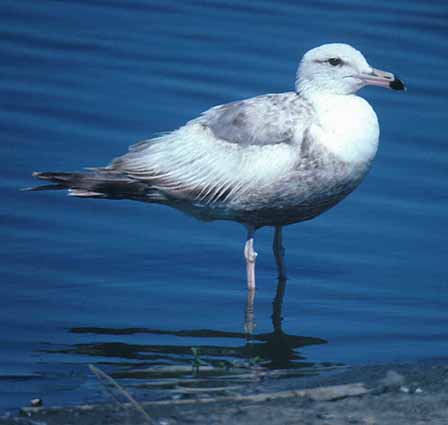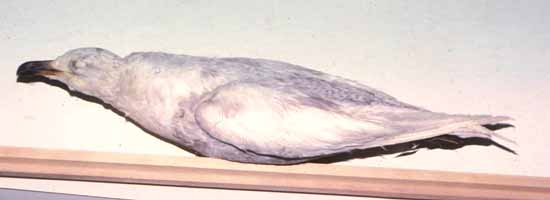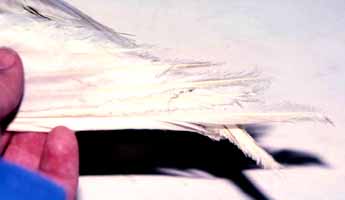"ONE MYSTERY SOLVED" . . . .
The story of a specimen-backed record of "Glaucous Gull" in Santa Cruz
by Don Roberson
Grinnell & Miller's (1944) The Distribution of the Birds
of California is the California birder's bible for details of past
status and distribution. The classic work is the underpinning of all current
distributional projects. The details published about ranges and dates are
almost always backed up by specimens, and thus are widely accepted as "true."
In most cases those details are, in fact, true.
 But
there can be exceptions. Recently, due to some posts on the "Monterey Bay
Birds" chat line and because (coincidentally) I was working on rewriting
the gulls section for Monterey Birds, 2d ed., the topic of summer
records of Glaucous Gull Larus hyperboreus around Monterey Bay came
up. The problem with summer claims of Glaucous Gull is that very worn first-year
gulls of other species, often Glaucous-winged Gulls but sometimes even
a worn California Gull (like the bird shown at right, photo'd at
Roberts Lake, Seaside, on 18 July 1980) can become so bleached as to appear
white, and can superficially have two-tone bills recalling Glaucous Gulls.
Those believing that there were some acceptable summer records of Glaucous
Gulls pointed to a specimen cited by Grinnell & Miller (1994) from
Santa Cruz, taken on 14 June 1938 and said to be #87919 at the Museum of
Vertebrate Zoology, U.S. Berkeley. In an MBB post in January, I wrote that
"I suspect the specimen may be misidentified" and thus might not support
other June-July-August claims of Glaucous Gull.
But
there can be exceptions. Recently, due to some posts on the "Monterey Bay
Birds" chat line and because (coincidentally) I was working on rewriting
the gulls section for Monterey Birds, 2d ed., the topic of summer
records of Glaucous Gull Larus hyperboreus around Monterey Bay came
up. The problem with summer claims of Glaucous Gull is that very worn first-year
gulls of other species, often Glaucous-winged Gulls but sometimes even
a worn California Gull (like the bird shown at right, photo'd at
Roberts Lake, Seaside, on 18 July 1980) can become so bleached as to appear
white, and can superficially have two-tone bills recalling Glaucous Gulls.
Those believing that there were some acceptable summer records of Glaucous
Gulls pointed to a specimen cited by Grinnell & Miller (1994) from
Santa Cruz, taken on 14 June 1938 and said to be #87919 at the Museum of
Vertebrate Zoology, U.S. Berkeley. In an MBB post in January, I wrote that
"I suspect the specimen may be misidentified" and thus might not support
other June-July-August claims of Glaucous Gull.
It is true that some late first-year Glaucous Gulls linger into May
-- maybe even to late May -- but beyond the specimen I was unaware of any
conclusive evidence of mid-summer Glaucous Gulls in central California.
There is a photo-documented bird from Monterey Bay on 2 Sep 1985 which
appears to be a Glaucous Gull and looks quite worn, strongly suggesting
that it over-summered someplace nearby. Summer birds thus are theoretically
possible, but how often and with what level of documentation was at issue.
On 17 Feb 2000, I visited MVZ and tried to locate the specimen. First
off, it wasn't in the Glaucous Gull drawers. So I asked the collections
manager, Dr. Carla Cicero, to help me search it out. She pointed out something
that I didn't know: the entire data-base for the MVZ collection is now
on-line at http://elib.cs.berkeley.edu/mvz/.We
punched in the specimen number ("87919") and got this response:
-
MVZ 87919 Larus glaucescens United States California Santa
Cruz Santa Cruz Clark P. Streator 14 Jan 1938 female study
skin
In English, this reads that Clark P. Streator collected this bird at Santa
Cruz, Santa Cruz Co., California, U.S.A., on 14 January 1938; it proved
to be a female and was made into a study skin; and it is now identified
as Larus glaucescens, the Glaucous-winged Gull. Several interesting
points appear in this line from the data-base. First of all, it seems it
has now been entered as a Glaucous-winged Gull -- not a Glaucous Gull at
all (!). Secondly, the date given is in January, which would mean that
there would be no fuss about this bird. In January, we have loads of Glaucous-wings
here plus a few Glaucous Gulls.
It seemed very odd that the both the i.d. and the date should be wrong,
so Dr. Cicero searched out the ORIGINAL accession card to the museum. This
was hand-written back when the specimen was given to the museum in 1941
by Mr. Streator. That accession cared showed the i.d. as Larus hyperboreus,
the Glaucous Gull, and the date was unmistakably 14 June, not January.
So what was published by Grinnell & Miller matches the original i.d.
and date. So the mystery deepened....

Dr. Cicero and I then went searching for the specimen and eventually
found it, resting among the Glaucous-winged Gulls. the photo above
is of specimen #87919. The wings and tail were very badly worn and
bleached white, with primary shafts protruding -- I knew before we looked
at the label it was a June bird.
 In
this hand-held shot (right; unfortunately "overflashed") you can
still get the feeling of the extremely worn wingtips. And indeed the label
confirmed the date: it was 14 June 1938 after all. [This means the data
entry was wrong in the data-base; one can expect typographical errors any
time large amounts of data are transferred. Dr. Cicero will also undertake
to correct the database after our adventure.]
In
this hand-held shot (right; unfortunately "overflashed") you can
still get the feeling of the extremely worn wingtips. And indeed the label
confirmed the date: it was 14 June 1938 after all. [This means the data
entry was wrong in the data-base; one can expect typographical errors any
time large amounts of data are transferred. Dr. Cicero will also undertake
to correct the database after our adventure.]
The bird is unquestionably a Glaucous-winged Gull, showing some
pale to the base of the bill as is typical of first-summer Glaucous-wings
but not nearly the bicolored sharpy-demarcated bill of first-year Glaucous
Gulls. The history of the re-identification appears on the label in pencil.
Streator had stated it was hyperboreus (Glaucous Gull) but his mistake
had been previously noticed and the specimen reidentified sometime later
by "D.J." who also wrote in pencil that the bird was glaucescens
and in "2nd year" plumage. This mistake in ageing was later corrected,
in pencil, to "first year" by "S.F.B." whom I know to be Stephen F. Bailey.
Mistakes in identification do occur among museum specimens. Just because
a bird was collected doesn't mean the collector and/or preparator could
identify it. But specimens are very useful because they can continue to
be reviewed indefinitely [likewise, photos or written details placed in
public institutions where they can be accessed can always to re-reviewed
years later]. In fact, another mistakenly-identified specimen that I found
at MVZ led to a publication that removed an entire species from the North
American list! [see Roberson & Pitelka 1983].
So the mystery of the "June specimen of Glaucous Gull" in Santa Cruz
is solved. It was a worn first-year Glaucous-winged Gull, and thus there
are no photo or specimen-backed records of Glaucous Gull anywhere on Monterey
Bay in June, July, or August. Indeed, after reviewing the database of late
spring/summer records in the North American Birds notebooks (thank
you, Steve Rottenborn), it appears a thorough review of all California
summer claims of this species may be warranted. In undertaking such a review,
here are some words of wisdom from Curtis Marantz (1986) in citing nine
accepted late fall and winter records in San Luis Obispo County (just to
the south of Monterey Co.): "Many of the record of [Glaucous Gull] probably
pertain to misidentified Glaucous-winged Gulls, thus numerous records with
unsatisfactory documentation have been rejected." I have taken this point
to heart, and therefore currently find no Monterey County records
of Glaucous Gull between 4 May and 2 September. Yet -- as the 2 September
bird shows -- it apparently can happen. But when it does, the record needs
thorough documentation.
Key lessons to be learned from this small mystery:
-
Specimens can be misidentified
-
Data bases -- even on-line data bases (!) -- may include errors [the date
in this case]
-
Any record that appears atypical or unseasonal is worth checking back to
its source
-
Critical review of records -- whether sight records, photos, or specimens
-- is appropriate
Literature cited:
Marantz, C. 1986. The birds of San Luis Obispo County, California: their
status and distribution. Senior thesis, Biol. Sci. Dept., School of Science
and Mathematics, Calif. Poly. State Univ., San Luis Obispo.
Roberson, D., and F. A. Pitelka. 1983. Occurrence of Willow Warbler
(Phylloscopus trochilus) in North America refuted. Condor 85: 258.
TOP
RETURN TO TOPICS
PAGE
TO MONTEREY PAGE
TO LIST OF FAMILIES
OF THE WORLD
TO HOME PAGE
Page created 23 Feb 2000
 But
there can be exceptions. Recently, due to some posts on the "Monterey Bay
Birds" chat line and because (coincidentally) I was working on rewriting
the gulls section for Monterey Birds, 2d ed., the topic of summer
records of Glaucous Gull Larus hyperboreus around Monterey Bay came
up. The problem with summer claims of Glaucous Gull is that very worn first-year
gulls of other species, often Glaucous-winged Gulls but sometimes even
a worn California Gull (like the bird shown at right, photo'd at
Roberts Lake, Seaside, on 18 July 1980) can become so bleached as to appear
white, and can superficially have two-tone bills recalling Glaucous Gulls.
Those believing that there were some acceptable summer records of Glaucous
Gulls pointed to a specimen cited by Grinnell & Miller (1994) from
Santa Cruz, taken on 14 June 1938 and said to be #87919 at the Museum of
Vertebrate Zoology, U.S. Berkeley. In an MBB post in January, I wrote that
"I suspect the specimen may be misidentified" and thus might not support
other June-July-August claims of Glaucous Gull.
But
there can be exceptions. Recently, due to some posts on the "Monterey Bay
Birds" chat line and because (coincidentally) I was working on rewriting
the gulls section for Monterey Birds, 2d ed., the topic of summer
records of Glaucous Gull Larus hyperboreus around Monterey Bay came
up. The problem with summer claims of Glaucous Gull is that very worn first-year
gulls of other species, often Glaucous-winged Gulls but sometimes even
a worn California Gull (like the bird shown at right, photo'd at
Roberts Lake, Seaside, on 18 July 1980) can become so bleached as to appear
white, and can superficially have two-tone bills recalling Glaucous Gulls.
Those believing that there were some acceptable summer records of Glaucous
Gulls pointed to a specimen cited by Grinnell & Miller (1994) from
Santa Cruz, taken on 14 June 1938 and said to be #87919 at the Museum of
Vertebrate Zoology, U.S. Berkeley. In an MBB post in January, I wrote that
"I suspect the specimen may be misidentified" and thus might not support
other June-July-August claims of Glaucous Gull.

 In
this hand-held shot (right; unfortunately "overflashed") you can
still get the feeling of the extremely worn wingtips. And indeed the label
confirmed the date: it was 14 June 1938 after all. [This means the data
entry was wrong in the data-base; one can expect typographical errors any
time large amounts of data are transferred. Dr. Cicero will also undertake
to correct the database after our adventure.]
In
this hand-held shot (right; unfortunately "overflashed") you can
still get the feeling of the extremely worn wingtips. And indeed the label
confirmed the date: it was 14 June 1938 after all. [This means the data
entry was wrong in the data-base; one can expect typographical errors any
time large amounts of data are transferred. Dr. Cicero will also undertake
to correct the database after our adventure.]